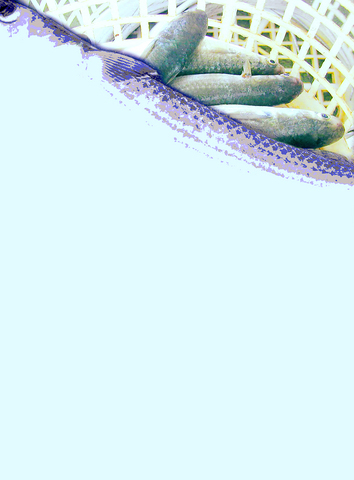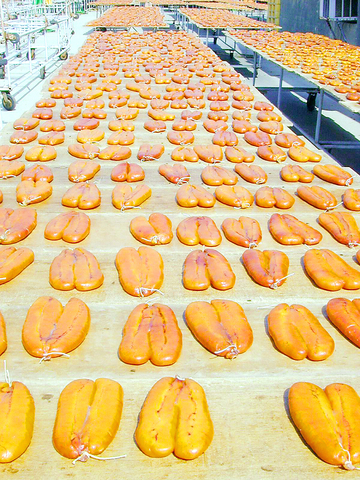A saying goes "eating gray mullet's golden eggs can bring you lots of good fortune every year!" Mullet roe -- also called black gold (烏金) -- is a must-have seafood treat on New Year's Eve dinner tables and propitiously, the cold fronts of the Lunar New Year period provide good catches.
In Taiwan, a large number of mullet come together and lay golden eggs in Kaohsiung County's Chiehting Township. The area is famous for selling and serving mullet roe that not only satisfies the appetites of visitors, but also allows them to take in the beauty of Taiwan's southern coastline.

There is no better place than the Hsingta Evening Fish Market (興達黃昏漁市) on the shore of the Hsingta Harbor in southern Taiwan to purchase mullet roe.

PHOTO: TAIPEI TIMES
Dusk is the most bustling time in the fish market. Reminiscent of a bygone era, fishermen yell into the crowd as they sell their catch in the open air, while pairs of mullet roe also catch people's attention and give the fish market more flavor and vitality.
A wide array of mullet roe can be selected from the Hsingta Harbor fish market, and since mullet processing factories are located nearby, people can also buy dried, processed mullet roe in the market.
Same-day catches of fresh, spotted crab, grass shrimp and mud crab stand out in vivid colors and arouse people's appetites. Their attractive prices make it doubly hard for people to resist.
If your stomach rumbles after shopping around the fish market, visitors can try a wide selection of seafood at stands in the cooked-food section of the market. Some recommended fresh dishes include oyster omelet, fried squid balls, squid potage and other fresh-made snacks.
A female mullet-roe processor called Auntie Yu-feng has nearly 20 years' experience in the roe-processing industry. In front of the factory one day in January, a large number of reddish mullet eggs -- the final catch of the spawning season -- were spread out under the sun.
But dried mullet roe is not simply processed by sun drying. Processing can be complicated and time-consuming.
While dexterously gathering fresh mullet roe that had been sun dried for a day, Auntie Yu-feng explained that sun drying is just a preliminary step, one that requires all-day attention. Roe needs to be turned over frequently for equal sunlight distribution and must be salted once every hour.
In general, processing mullet roes takes two to three days. The roe is cleaned of blood, gall bags, bits of intestines and membrane. It is washed thoroughly and drained, then rolled in fine salt: about 454g of salt per 4.5kg of roe.
The roe is removed from the salt after 6 to 12 hours and brushed well to remove excess salt. It is then laid out to dry.
The roe must be turned at least every hour during the first day and must be brought indoors in the evening. Boards and weights are placed on the roe during the first night or two to compress them slightly.
The roe is cured for about one week -- if drying conditions are good -- until it is reddish-brown and feels hard. Dried roe is dipped in melted beeswax, cooled for 15 minutes, wrapped in waxed paper and stored in a cool dry place.
When the mullet roe is buried in salt and hung to mature it continues to produce water, oil and salt crystals, so it's necessary to frequently wipe and turn over the roe. The mullet roe is flattened and reshaped with wood planks, after dark, and after a while, it are ready to be packaged for sale.
In the past, the fishermen of Chiehting Township could catch big hauls of "black gold" as a means of obtaining a living for a year. Locals even called mullet roe hsin yu (信魚), reliable fish, because, every year, the roe would arrive on the Kuroshio current off Taiwan's southwestern coast.
Mullet roe catches have declined in recent years and Auntie Yu-feng sighed and complained about how few mullet have made the journey along Taiwan's western coast, where the water in the southern Taiwan Strait has become too warm for the fish.
Unfortunately, apart from lengthy expeditions and dynamite fishing by Chinese fishermen, a reduced number of boats for mullet fishing have also contributed to recent low yields.
The poor local harvests have meant that most mullet roe is now imported from China, and mullet is no longer a source of prosperity for local fishermen in places like Chiehting Township, a place that has about a hundred years of mullet-catching history.
Mullet sold in the market can be primarily classified as marine-captured (or wild), imported and cultured. There is another kind of mullet called hsieh tzu (血子), deemed a second-class mullet because of dark-red bruises on its flesh from being roughly handled during transportation.
Deep-sea mullet usually commands premium prices, but such mullet is mostly imported from China, Brazil and Australia. It's difficult to distinguish different types of mullet, but there are several tips to keep from getting mixed up.
"Wild mullet roe looks slender and darker compared to artificially cultured roe, the flesh of which is thicker, fattier and a lighter color," said Aunty Yu-feng. Furthermore, pairs of roe sacs in which the eggs live must not be damaged and should be symmetrical. All the eggs should be similar in size.
Price can also be a basis for mullet-roe selection. Roe of marine-captured mullet fetch the highest price in the market, and the bigger the roe sac, the higher in price.
Due to low mullet crops in recent years, whether imported or artificially cultured, the price of all mullet roe this year has increased by 10 percent. In the market today, 200g of mullet roe costs at least NT$300 (US$10).
Other than mullet roe, Hsingta Fish Market is also famous for selling other mullet products such as processed stomach and mullet's air bladder, which are also regarded as luxury items for epicures.
-- translated by Lin Ya-ti";

The unexpected collapse of the recall campaigns is being viewed through many lenses, most of them skewed and self-absorbed. The international media unsurprisingly focuses on what they perceive as the message that Taiwanese voters were sending in the failure of the mass recall, especially to China, the US and to friendly Western nations. This made some sense prior to early last month. One of the main arguments used by recall campaigners for recalling Chinese Nationalist Party (KMT) lawmakers was that they were too pro-China, and by extension not to be trusted with defending the nation. Also by extension, that argument could be

Aug. 4 to Aug. 10 When Coca-Cola finally pushed its way into Taiwan’s market in 1968, it allegedly vowed to wipe out its major domestic rival Hey Song within five years. But Hey Song, which began as a manual operation in a family cow shed in 1925, had proven its resilience, surviving numerous setbacks — including the loss of autonomy and nearly all its assets due to the Japanese colonial government’s wartime economic policy. By the 1960s, Hey Song had risen to the top of Taiwan’s beverage industry. This success was driven not only by president Chang Wen-chi’s

Last week, on the heels of the recall election that turned out so badly for Taiwan, came the news that US President Donald Trump had blocked the transit of President William Lai (賴清德) through the US on his way to Latin America. A few days later the international media reported that in June a scheduled visit by Minister of National Defense Wellington Koo (顧立雄) for high level meetings was canceled by the US after China’s President Xi Jinping (習近平) asked Trump to curb US engagement with Taiwan during a June phone call. The cancellation of Lai’s transit was a gaudy

The centuries-old fiery Chinese spirit baijiu (白酒), long associated with business dinners, is being reshaped to appeal to younger generations as its makers adapt to changing times. Mostly distilled from sorghum, the clear but pungent liquor contains as much as 60 percent alcohol. It’s the usual choice for toasts of gan bei (乾杯), the Chinese expression for bottoms up, and raucous drinking games. “If you like to drink spirits and you’ve never had baijiu, it’s kind of like eating noodles but you’ve never had spaghetti,” said Jim Boyce, a Canadian writer and wine expert who founded World Baijiu Day a decade